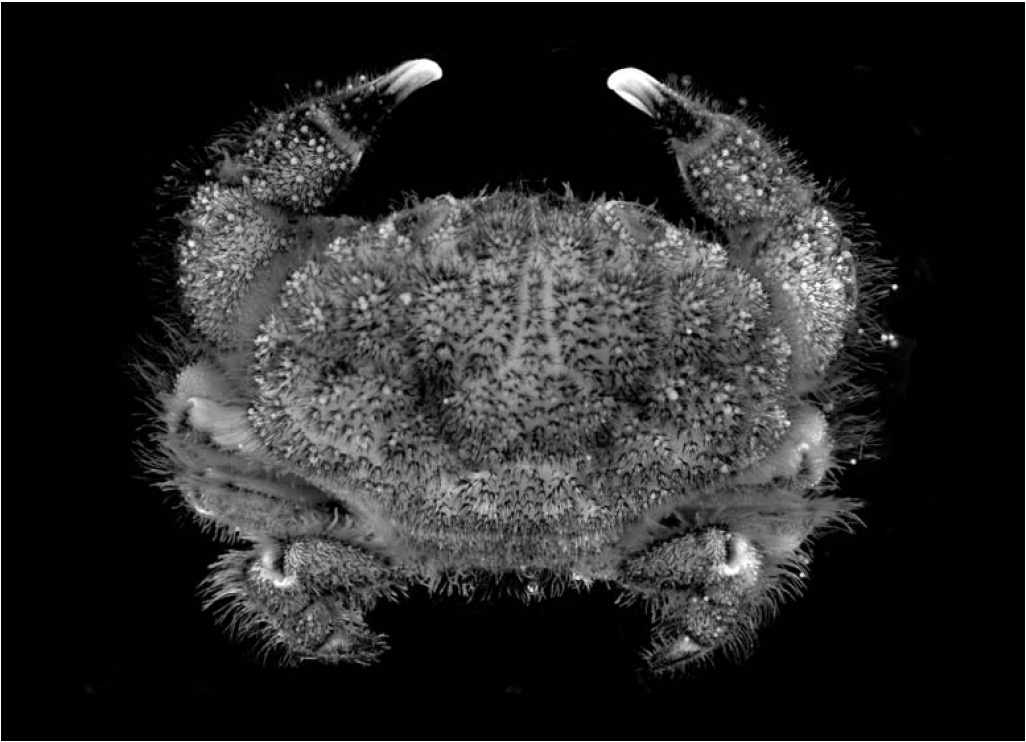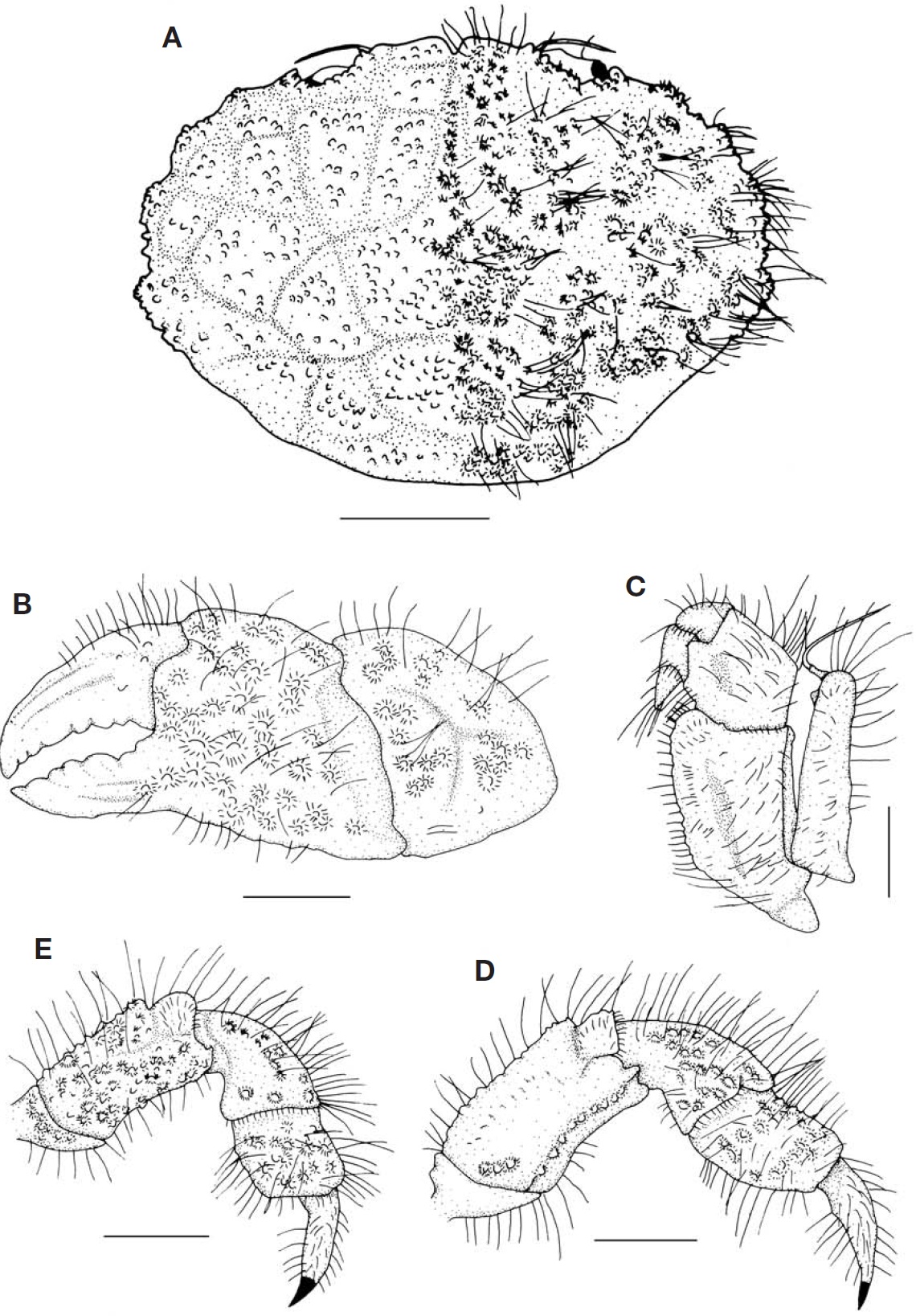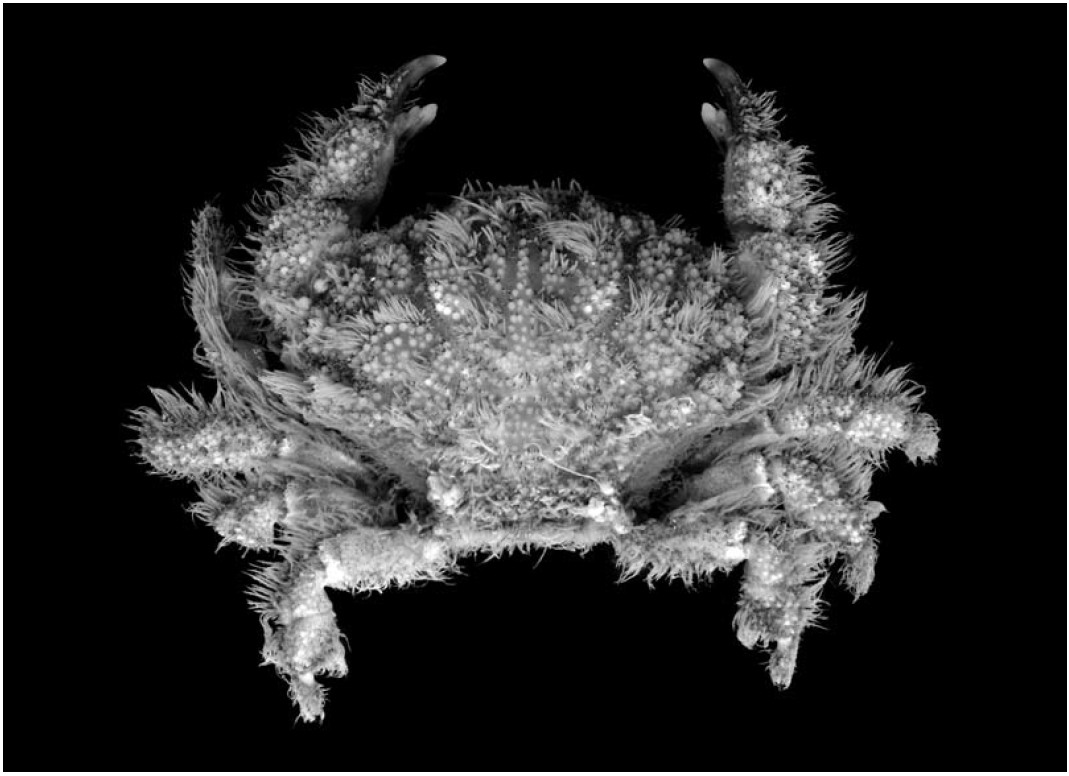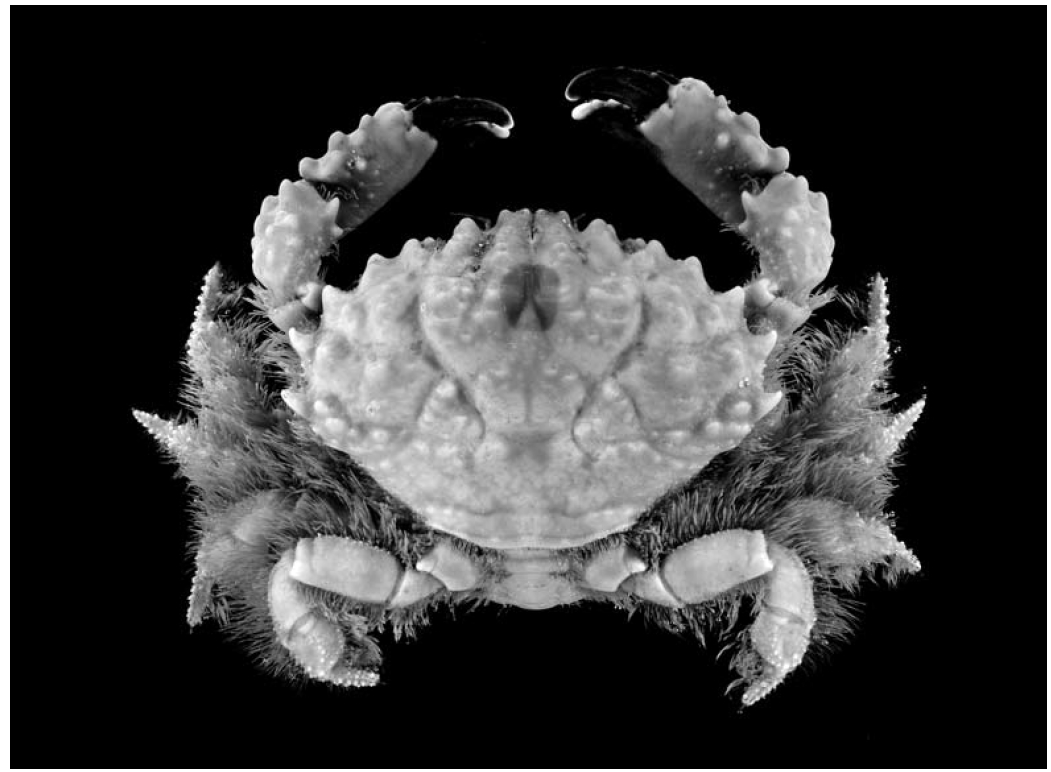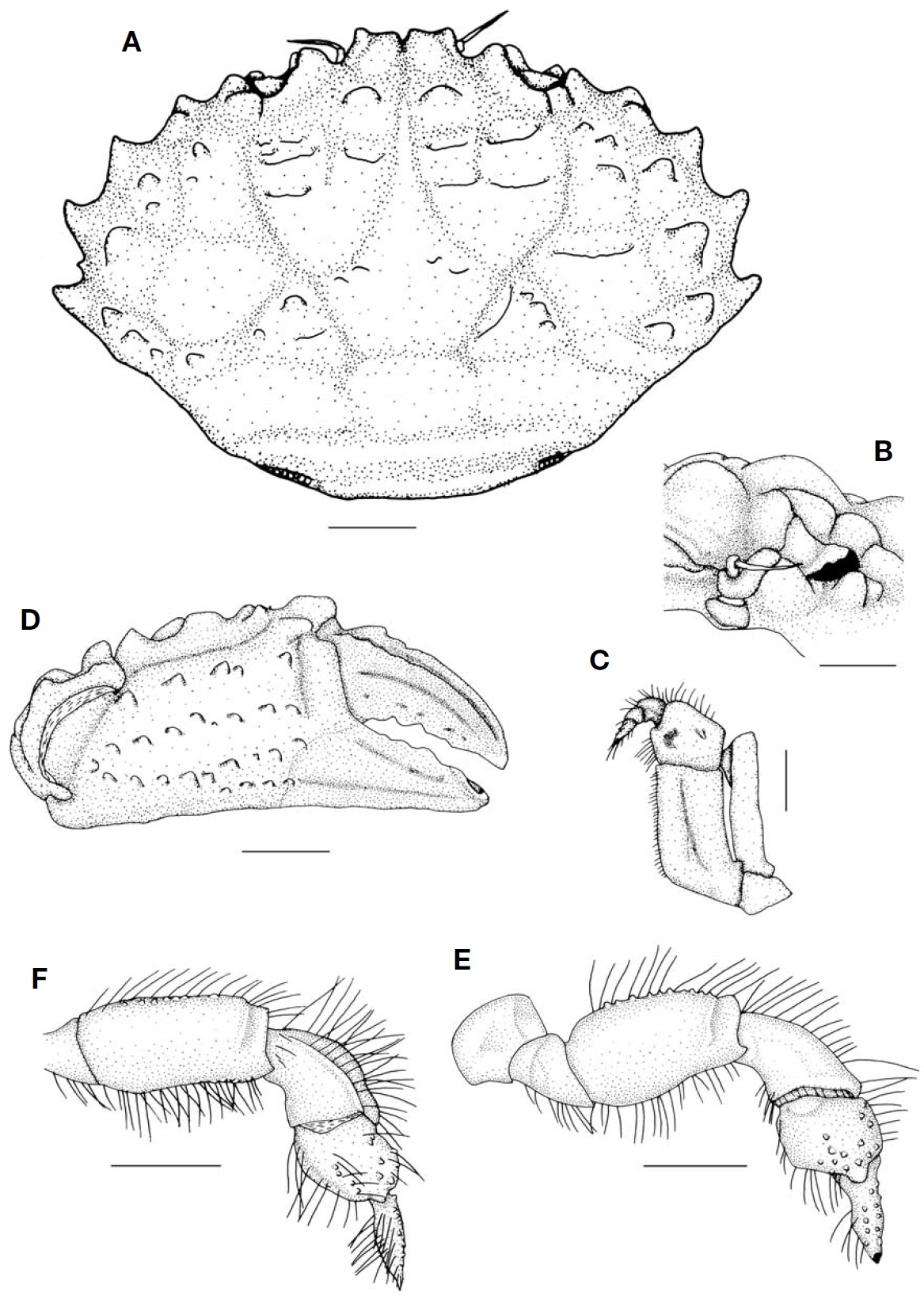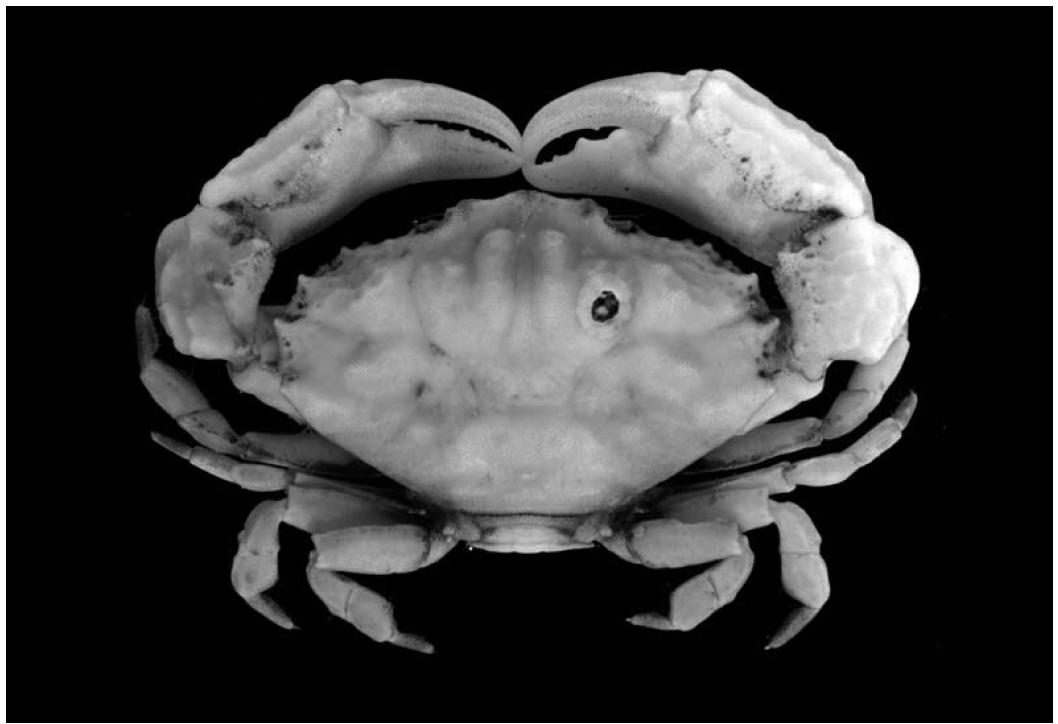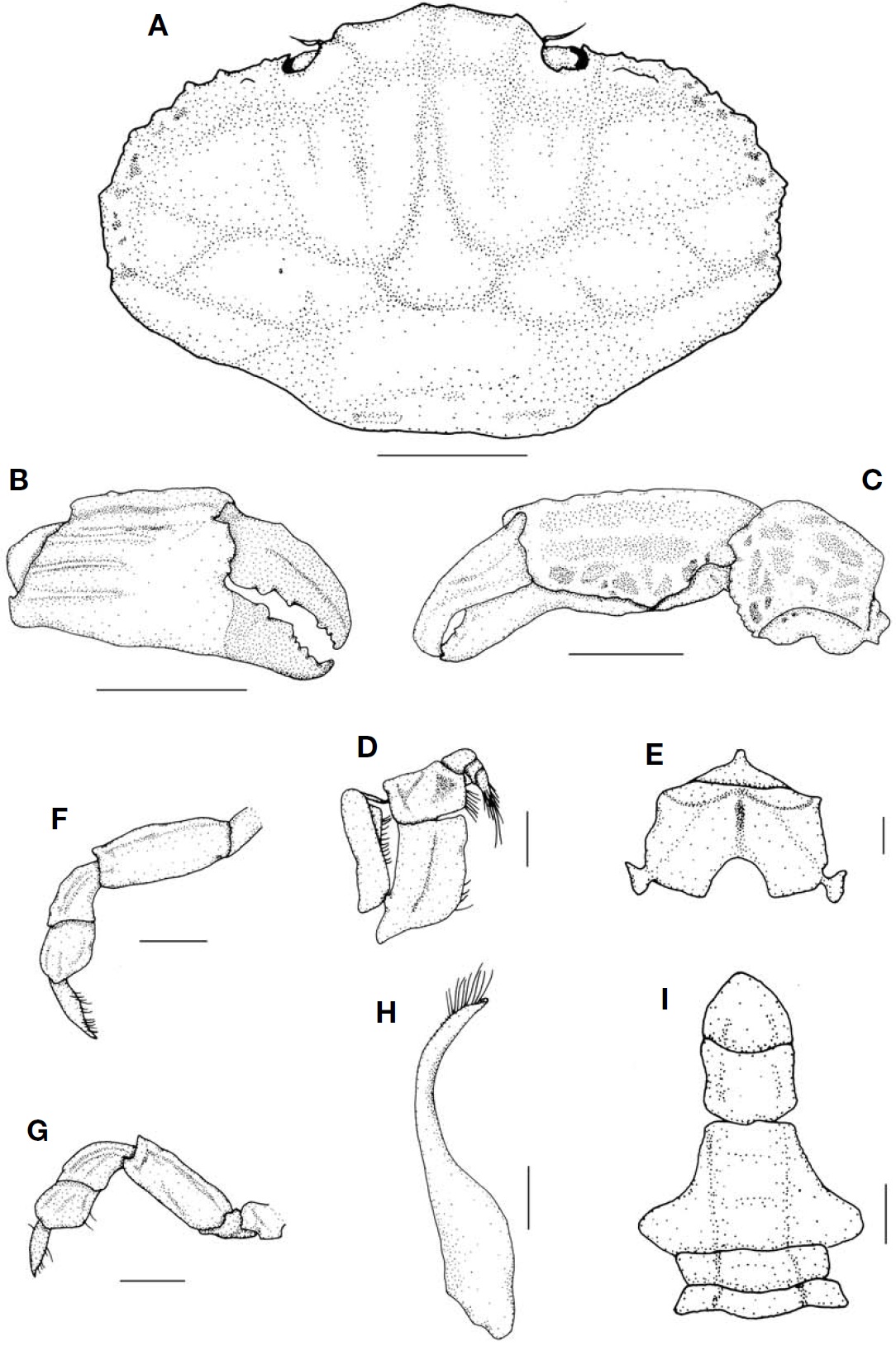



Many members of the family Xanthidae MacLeay, 1838 have the black colored fingers. Most of them occur in the Indo-West Pacific area and they are found easily in the inter-tidal or subtidal zone. They hide under the rocks or in spo-nges and other sessile invertebrates, and graze on algae or detritus.
Twenty-five species of 22 genera belonging to the family Xanthidae have been recorded in Korean fauna.
Materials examined in this study were preserved in 95% ethyl alcohol, and deposited in the Marine Arthropod Depository Bank of Korea (MADBK), Seoul National University. The specimens were observed under SZ 12 binocular stereomicro-scope (Leica, Wetzlar, Germany). Drawings were made with the aid of Camera Lucida. Images were recorded using D7000 digital camera (Nikon Imaging Korea, Seoul, Korea), and developed with Helicon Focus software (Helicon Soft, Khar-kov, Ukraine).
The abbreviations “cl,” “cw,” and “G1” refer to the cara-pace length from the front to the posterior dorsal margin of the carapace, to the width of the carapace measured at the widest part, and to the first gonopod of male, respectively. All characters were measured using metric dial calipers (Wiha, Monticello, MN, USA). The zones of the carapace (1-3M, 1F, 2F, 1-4L, and 1-2P) were divided according to Dana (1852) and Serene (1984). The classification follows that of Ng et al. (2008).
Order Decapoda Latreille, 1802
Family Xanthidae MacLeay, 1838
Subfamily Actaeinae Alcock, 1898
Genus Gaillardiellus Guinot, 1976
1*Gaillardiellus rueppelli (Krauss, 1843) (Figs. 1, 2)
Material examined. 1♀ (cl 25.4 mm, cw 32 mm), Korea: Jejudo, Isl. Munseom, 21 Jan 1997.
Comparative materials.
Description. Carapace (Figs. 1, 2A) transversely oval; sur-face thickly covered with granules and short setae, inter-spersed with long setae; all regions divided into lobules by deep smooth grooves; 2M completely divided into two lob-ules; outer lobule convex and broader; 1P also well convex and circular. Front (Figs. 1, 2A) divided into two lobes by median V-shaped notch. Orbit (Figs. 1, 2A) with dorsal mar-
gin convex. Anterolateral border (Figs. 1, 2A) composed of four convex lobes excluding external orbital angle: first and last smaller, second and third broader. Posterolateral border (Figs. 1, 2A) shorter than anterolateral one, and slightly con-cave. Third maxilliped (Fig. 2C) completely covering buccal orifice, bearing seta on surface; ischium subrectagular; merus subquadrate with seta, and angled on anterolateral border.
Chelipeds (Figs. 1, 2B) symmetrical, and covered with granules and long setae. Carpus massive, larger than propo-dus, and covered with tubercles separating by shallow grooves on upper surface. Propodus short and small, with 3 tubercles on dorsal surface, marked with transverse granulated carinae.Dactylus with tip bluntly round.
Ambulatory legs (Figs. 1, 2D, E) stout. Merus with long setae along anterior margin and granules on dorsal surface; first to third pairs relatively smooth. Carpus with longitudinal groove. Dactylus with tip claw-shaped.
Distribution. Australia, China, Indonesia, Japan, Kenya, Madagascar, Mauritius, Mergui Archipelago, Papua New Guinea, Persian Gulf, Philippines, Samoa, Singapore, South Africa, Tahiti, and Korea (the present study).
Remarks. The present specimen (Fig. 1) agrees with the description by Dai and Yang (1991). In Korean fauna, only
The distribution of setae on the carapace of
Subfamily Etisinae Ortmann, 1893
Genus 1*Etisus H. Milne Edwards, 1834
2*Etisus anaglyptus H. Milne Edwards, 1834 (Figs. 4, 5)
456, fig. 246; Serene, 1984: 219(key), 223(key), 228, Pl. 32A, fig. 137; Dai and Yang, 1991: 324, Pl. 42(3); Ng et al., 2001: 27; Ng et al., 2008: 198.
Material examined. 1♀ (cl 25.6 mm, cw 37.5 mm), Korea: Gyeongsangbuk-do, Uljin-gun, Deokcheon-ri, 25 Aug 2010, Park TS, by SCUBA diving.
Description. Carapace (Figs. 4, 5A) transversely oval, about 1.46 times as broad as long; surface not smooth, slight rugose with sparse pits; regions well defined by grooves: gastric-cardiac regions with H-shaped groove distinct. Front (Figs. 4, 5A) narrow, produced, 0.15 times as broad as carapace width, divided into two lobes by V-shaped median notch. Orbital (Figs. 4, 5A, B) complete, very narrow orbital hiatus being completely filled up by prolonged lobule from basal antennal segment; inner angle obtuse and outer angle tuber-cular; inner angle of ventral margin very produced and visible from above. Third maxilliped (Fig. 5C) completely covering buccal orifice; ischium subrectagular; merus subquadrate. Anterolateral border (Figs. 4, 5A) armed with four teeth exclusive of external orbital angle; first two obtuse, last two obtusely pointed and curved forward; transverse groove deep behind last teeth.
Chelipeds (Figs. 4, 5D) covered with fine granules except for ventral surface. Carpus with three tubercles on dorsal sur-face, six tubercles on outer surface, and two tubercles on inner surface. Propodus weakly compressed and bearing four or five tubercles on superior border and about six smaller ones on outer surface. Dactylus with four teeth on either inner margin; tip spoon-shaped, with a tuft of setae.
Ambulatory legs (Fig. 5E, F) stubby, with long hairs along both margins; merus and carpus with granular spines on anterior margins; carpus with granulated ridge on dorsal surface; propodus and dactylus also covered with granular spines.
Habitat. Rocky or stony beaches, under stones or in crevices of rocks, shallow waters.
Distribution. Australia, China, India, Japan, Madagascar, Red Sea, Samoa, Taiwan, Vietnam, and Korea (the present study).
Remarks. According to Dai and Yang (1991), and Sakai (1976),
occupying the orbital hiatus, feebly developed frontal margin from the supra-orbital angles, and numerous long setae and granular spines on ambulatory legs. The characteristics of the present specimen agree well with their description.
Subfamily Euxanthinae Alcock, 1898
Genus 1*Danielea Ng and Clark, 2003
2*Danielea noelensis (Ward, 1934) (Figs. 6, 7)
Material examined. 1♂ (cl 9.5 mm, cw 14.3 mm), Korea: Jejudo, Isl. Beomseom, 6 Jun 2001.
Description. Carapace (Figs. 6, 7A) transversely oval; dorsal surface gently convex; regions densely covered with small, evenly sized rounded granules. Front (Figs. 6, 7A) weakly produced, divided into two broad lobes by small, narrow fissure. Orbits (Figs. 6, 7A) subparallel with frontal margin;
inner supraobital tooth low and rounded; external orbital tooth low and undiscernible. Eyestalk granulated. Anterolate-ral border (Figs. 6, 7A) with four broad teeth; first tooth very low; next three teeth low, each with median prominence. Posterolateral border (Figs. 6, 7A) gently convex to almost straight, wider than frontal margin. Basal antennal segment subrectangular, free but filling orbital hiatus. Surface of third maxilliped (Fig. 7D) densely covered with evenly sized small rounded granules; merus squarish and rather projecting on anteroexternal angle. Thoracic sternum (Fig. 7E) relatively broad, surface entirely; suture between sternites 2 and 3 well-developed, complete; suture between sternites 3 and 4 pro-minent but becoming shallow medially.
Chelipeds (Figs. 6, 7B, C) elongate; outer surfaces densely covered with evenly sized granules. Dorsal margin of merus granular. Carpus rounded rugose on dorsal surface, inner angle with one prominent rounded tooth and several tuber-cles anteriorly. Propodus with prominent uneven, almost subpetaloid crest on subdorsal inner surface. Right cheliped with two teeth and pronounced curved basal cutting tooth on cutting edge of dactylus. Left cheliped with fingers more slender, cutting edges blade-like, each with two or three teeth and two or three denticles.
Ambulatory legs (Figs. 6, 7F, G) with all segments unarmed, almost glabrous; surfaces densely covered with evenly sized small rounded granules. Merus entirely cristate on anterior margin. Carpus with distal part of dorsal margin subcristate, produced into rounded tooth.
Abdomen of male (Fig. 7I) with segments 3-5 completely fused, sutures separating segments not discernible, lateral margins entire, without clefts; segments 1-3 trapezoidal, seg-ment 6 rectangular, lateral margins gently concave, subpar-allel; telson semicircular, lateral margins distinctly convex, tip rounded; surfaces of all segments covered with numer-ous small evenly sized granules.
First gonopod of male (Fig. 7H) relatively stout, gently curved, tip blunt; lateral margins lined with short spines and long plumose setae on disto-dorsal margin.
Distribution. Christmas Island, Japan, Madagascar, Mauri-tius, Philippines, Red Sea, Samoa, Tahiti, and Korea (the present study).
Remarks. The present specimen agrees well with the descrip-tion of Ng and Clark (2003) except for antero-external angle of merus of third maxilliped (Fig. 7D). In their
merus of each ambulatory leg. However,
Korean name: 1*짧은털부채게 (신칭)
Korean name: 1*돋음부채게속, 2*돋음부채게
Korean name: 1*잔물결부채게속, 2*잔물결부채게


